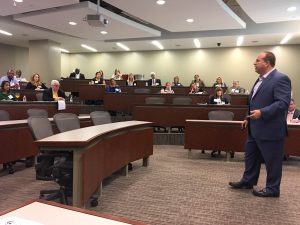PESA’s HR Committee held an HR Seminar highlighting future human capital trends, requirements and challenges at the Texas A&M Mays Business School in Houston on October 12, 2016. The half-day seminar included a presentation on CEO expectations of HR as well two panel discussions focused on Integration and Operator/Customer Challenges.

PESA Advisory Board Member Charles Davison, President & CEO, FairfieldNodal
PESA Advisory Board Member Charles Davison, President & CEO, FairfieldNodal, presented on CEO expectations of HR where he identified several critical drivers to value and success within the Human Resources department. HR executives that develop strong business acumen, become integral to the business strategy, and uncover root causes of problems within the organization were highlighted.
Mr. Davison also spoke about Human Resources of today as being part of the business strategy rather than simply transactional. He stressed the importance of balancing between tactical fundamentals and providing a voice and conscience of the organization. “HR has to have a seat at the table for leadership to provide balance for management teams,” he said.
Every element of the industry is currently going through some kind of change or transformation, and Davison addressed this topic, as well as culture. He urged seminar attendees to help their leaders keep the organization’s roots firmly planted during any type of transformation. His message was to cultivate what is good in the culture and work to improve areas that need guidance: “I believe that instead of trying to change culture; strong leaders influence culture,” he said.
Davison ended his presentation by reminding HR leadership to ensure they understand details of their company’s direction and customers. Executing leadership by showing the internal management teams how HR adds value, as well as striving to fully appreciate the business, will secure that essential “seat at the table” all Human Resources departments need to have.
Integration Panel
Wayne Finger, HR Integration Manager, Cameron, a Schlumberger Company and Lara Isaacs, Director of Human Resources at DistributionNOW, presented on an Integration Panel. HR Committee Member Terry Woodall, VP Human Resources, Oil States Energy Services moderated.
Mr. Finger touched upon principal themes related to successful integration: importance of culture, how to assess culture, and incorporating transition plans.
Finger explained that over half of mergers and acquisitions fail to meet expectations due to cultural differences and therefore stressed the importance of assessing the culture of both companies in an acquisition. “It’s critical that you dedicate resources to look at culture. Otherwise it will be a business-type of integration and you will get lost.” He also noted that gathering and analyzing data, which is the initial part of the transition plan, adds value by leveraging similarities and managing differences.
Lara Isaacs discussed the blending of companies and importance of educating employees on background behind the acquisition. Keeping employees informed, actively communicating decisions and incorporating all functions throughout the integration are all best practices. “People are your first priority, engagement is key,” she said.
Isaacs also emphasized post-close reviews; bringing functional teams together to identify lessons learned and prioritizing open communication with senior leadership.
The key takeaway from this experienced panel was that during any integration you have to assess both companies, how they function, recognize what their processes are, and understand what the end result will look like once blended.
Operator Panel
The operator panel was led by Khymberly Booth, VP Human Resources, BP America; Glenda de Silano, HR General Manager, Chevron Africa and Latin America Exploration and Production Company; Karla Lundquist, Human Resources Director, Oasis Petroleum; and moderated by HR Committee Member Susan Webb, Global Human Resources, FMC Technologies, Inc.
The final panel spoke to challenges HR is currently facing in the Operator community; namely generation gaps, motivating recent graduates to join the oil & gas industry, and talent development roadblocks.
Khymberly Booth discussed how the current oil and gas industry workforce spans across four generations and challenges around these talented generations working together. She also spoke about the struggle to keep our industry attractive to students and recent graduates.
Glenda di Silano examined the internal challenges organizations can face such as data accuracy issues due to inconsistent data infrastructure platforms and costly internal talent development programs. In the current environment, it is difficult to keep business simulations and other internal programs as available as possible to employees without cost modifications.
Karla Lundquist spoke about the advantages and disadvantages of working in a smaller company. Developing people, curriculums and core competencies is critical, but in the current downturn keeping people motivated until those curriculums can be implemented is a challenge.
The overarching theme for this panel was clear: People are our biggest asset and we must work to continuously train, develop and motivate our current and future workforce.




